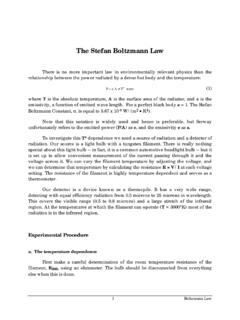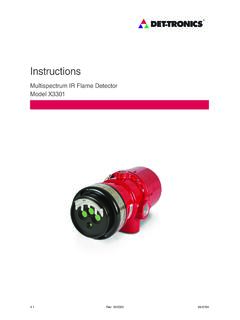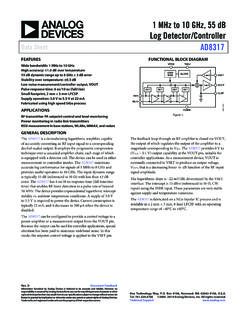Transcription of Thermistor Calibration and the Steinhart-Hart Equation
1 For application assistance or additional information on our products or services you can contact us at: ILX Lightwave Corporation 31950 Frontage Road, Bozeman, MT 59715 Phone: 406-556-2481 800-459-9459 Fax: 406-586-9405 Email: To obtain contact information for our international distributors and product repair centers or for fast access to product information, technical support, LabVIEW drivers, and our comprehensive library of technical and application information, visit our website at: Copyright 2006 ILX Lightwave Corporation, All Rights Reserved #4 Thermistor Calibration and theSteinhart-Hart Equation1 Thermistors provide an inexpensive and accurate temperature monitor for use with laser diodes. The nonlinear resistance -temperature characteristics of a Negative-Temperature Coeffi cient (NTC) Thermistor may be modeled to a high degree of accuracy using the Steinhart-Hart Equation , LaGrange polynomials, or other modeling techniques.
2 Figure 1 shows a common R-T relation curve for a 10k NTC 1968, Steinhart and Hart developed a model for Thermistor R-T characteristics in order to make accurate temperature measure-ments for oceanic studies. Today, the most popular model for R-T characterization is the Steinhart-Hart Equation . This publication describes two methods for calibrating thermistors using the Steinhart-Hart Equation ; the fi rst method may be used with the ILX Lightwave Model LDT-5948 and LDT-59801 Temperature Controllers, or any other temperature controller which uses the Steinhart-Hart Equation . The second form of the Equation is simpler, and is used when only the fi rst two Steinhart-Hart constants are Steinhart-Hart EquationThe three-term Steinhart-Hart Equation ( Equation 1) is the most popular model used for Thermistor R-T modeling.
3 (1) 1/T = C1 + C2 * ln(R) + C3 * ln(R)3 Where T is the absolute temperature in Kelvin and R is the Thermistor resistance in ohms. The terms C1, C2, and C3 are the Steinhart-Hart constants for the simpler, two-term form of the Steinhart-Hart Equation ( Equation 2) may be used in some cases .(2) 1/T = C1 + C2 * ln(R)Note that C1 C1 and C2 Methods to Calculate the Steinhart-Hart ConstantsThree methods for calculating the constants of the Steinhart-Hart Equation are summarized in Table 1. Computer programs are available electronically, free of charge, from your ILX Lightwave representative, or from the Downloads section of our (C) resistance (k Ohms)1 Three-Term Steinhart-Hart Equation is also used in ILX Lightwave Model 39xx and 37xx Laser Diode 1. NTC R-T response Calibration and the Steinhart-Hart EquationThe following publications are available for download on at Papers A Standard for Measuring Transient Suppression of Laser Diode Drivers Degree of Polarization vs.
4 Poincar Sphere Coverage Improving Splice Loss Measurement Repeatability Technical Notes Attenuation Accuracy in the 7900 Fiber Optic Test System Automatic Wavelength Compensation of Photodiode Power Measurements Using the OMM-6810B Optical Multimeter Bandwidth of OMM-6810B Optical Multimeter Analog Output Broadband Noise Measurements for Laser Diode Current Sources Clamping Limit of a LDX-3525 Precision Current Source Control Capability of the LDC-3916371 Fine Temperature Resolution Module Current Draw of the LDC-3926 16-Channel High Power Laser Diode Controller Determining the Polarization Dependent Response of the FPM-8210 Power Meter Four-Wire TEC Voltage Measurement with the LDT-5900 Series Temperature Controllers Guide to Selecting a Bias-T Laser Diode Mount High Power Linearity of the OMM-6810B and OMH-6780/6790/ 6795B Detector Heads Large-Signal Frequency Response of the 3916338 Current Source Module Laser Wavelength Measuring Using a Colored Glass Filter Long-Term Output Drift of a LDX-3620 Ultra Low-Noise Laser Diode Current Source Long-Term Output Stability of a LDX-3525 Precision Current Source Long-Term Stability of an MPS-8033/55 ASE Source LRS-9424 Heat Sink Temperature Stability When Chamber Door Opens Measurement of 4-Wire Voltage Sense on an LDC-3916 Laser Diode Controller Measuring the Power and Wavelength of Pulsed Sources Using the OMM-6810B Optical Mutlimeter Measuring the Sensitivity of the OMH-6709B Optical Measurement Head Measuring the Wavelength of Noisy Sources Using the
5 OMM-6810B Optical Multimeter Output Current Accuracy of a LDX-3525 Precision Current Source Pin Assignment for CC-305 and CC-505 Cables Power and Wavelength Stability of the 79800 DFB Source Module Power and Wavelength Stability of the MPS-8000 Series Fiber Optic Sources Repeatability of Wavelength and Power Measurements Using the OMM-6810B Optical Multimeter Stability of the OMM-6810B Optical Multimeter and OMH-6727B InGaAs Power/Wavehead Switching Transient of the 79800D Optical Source Shutter Temperature Controlled Mini-DIL Mount Temperature Stability Using the LDT-5948 Thermal Performance of an LDM-4616 Laser Diode Mount Triboelectric Effects in High Precision Temperature Measurements Tuning the LDP-3840 for Optimum Pulse Response Typical Long-Term Temperature Stability of a LDT-5412 Low-Cost TEC Typical Long-Term Temperature Stability of a LDT-5525 TEC Typical Output Drift of a LDX-3412 Loc-Cost Precision Current Source Typical Output Noise of a LDX-3412 Precision Current Source Typical Output Stability of the LDC-3724B Typical Output Stability of a LDX-3100 Board-Level Current Source Typical Pulse Overshoot of the LDP-3840/03 Precision Pulse Current Source Typical Temperature Stability of a LDT-5412 Low-Cost Temperature Controller Using Three-Wire RTDs with the LDT-5900 Series Temperature Controllers Voltage Drop Across High Current Laser Interconnect Cable Voltage Drop Across High Current TEC Interconnect Cable Voltage Limit Protection of an LDC-3916 Laser Diode Controller Wavelength Accuracy of
6 The 79800 DFB Source Module Application Notes App Note 1: Controlling temperatures of Diode Lasers and Detectors Thermoelectrically App Note 2: Selecting and Using Thermistors for Temperature Control App Note 3: Protecting Your Laser Diode App Note 4: Thermistor Calibration and the Steinhart-Hart Equation App Note 5: An Overview of Laser Diode Characteristics App Note 6: Choosing the Right Laser Diode Mount for Your Application App Note 8: Mode Hopping in Semiconductor Lasers App Note 10: Optimize Testing for Threshold Calculation Repeatability App Note 11: Pulsing a Laser Diode App Note 12: The Differences between Threshold Current Calculation Methods App Note 13: Testing Bond Quality by Measuring Thermal resistance of Laser Diodes App Note 14: Optimizing TEC Drive Current App Note 17: AD590 and LM335 Sensor Calibration App Note 18: Basic Test Methods for Passive Fiber Optic Components App Note 20: PID Control Loops in Thermoelectric Temperature Controllers App Note 21: High Performance Temperature Control in Laser Diode Test Applications 2of the other two tolerances.
7 The three factors are related as shown in Equation 3.(3) Ttol = Rtol / When a Thermistor is calibrated with the Steinhart-Hart model, its temperature tolerance over that range is improved to the tolerance of the model. Therefore, an inexpensive Thermistor calibrated to C will be just as accurate as an expensive ( tight tolerance) Thermistor that is also calibrated to C over the same temperature AccuracyAn LDT-5948 or 5980 or other ILX Temperature Controller may be used to independantly measure the temperature when calibrating a Thermistor . However, to guarantee accuracy, the instrument s resistance measurement must be accurately calibrated and a previously calibrated Thermistor (with the Steinhart-Hart coeffi cients entered) must be used to measure the temperature. Also, accuracy will be reduced by the temperature resolution of the instrument, unless the temperature is queried via vs.
8 AccuracyTemperature accuracy, which is the variance from true temperature, depends primarily on the Thermistor Calibration . Temperature stability, which is the invariance from the set temperature, depends on the controller design and the environment of the Thermistor and TE an LDT-5948 or 5980 is used, short-term temperature stability of C or better can be Excel version of is printed in the 1 Three Methods of CalculatingConstants C1, C2, C3 Table 1 Notes:1 Accuracy over 0 C to 50 C range; assuming temperature and resistance readings are accurate to four Using 10k Thermistor and ILX Lightwave model LDT-5910B temperature Using 10k Thermistor and ILX Lightwave model LDT-5525 temperature Regarding Temperature AccuracyThe method of Thermistor Calibration will depend on the accuracy requirements for the particular application.
9 Table 1 shows the expected accuracies using the three different RatingsManufacturers specify Thermistor tolerances in several ways, usually with the resistance tolerance (Rtol) or temperature tolerance (Ttol), and the temperature coeffi cient of resistance ( ). The rated Rtol and Ttol are typically given for 25 C with additional deviation factors for other temperatures . The temperature coeffi cient of resistance ( ) is the percentage change of resistance for a 1 C change in temperature, and may be specifi ed with one APPENDIX - Method 1 Excel SpreadsheetType in the equations as shown. Temperature readings are entered in Cells C3-C5; resistance readings are entered in Cells F3-F5. The results are shown in Cells F9-F11, and are scaled so they may be entered into the LDT-5910B Temperature Values HereEnter resistance Values Here3T1 =T1R1 =R14T2 =T2R2 =R25T3 =T3R3 =R367T1K = =C3+ = =C4+ are shown here9T3K = =C5+ = =C22*1000000010C2 = =C23*1000011A1 = =LN (F3)C1 = =C24*100012A2 = =LN(F4)13A3 = =LN(F5)1415Z ==C11-C1216Y ==C11-C1317X = =1/C7 - 1/C818W = =1/C7 - 1/C919V = =C11^3 - C12^320U = =C11^3 - C13^32122C3a = =(C17-C15*C18/C16)/(C19-C15*C20/C16)23C2 a = =(C17-C22*C19)/C1524C1a = =1/C7-C22*C11^3-C23*C112536 Often, the Thermistor manufacturer will provide R-T values, but the accuracy of these values depends on the resistance tolerance of the Thermistor .
10 When a high temperature toler-ance is required, it is recommended that these R-T values be discarded and new values be measured as described below. For some applications, the nominal R-T data is adequate and the Steinhart-Hart constants can be calculated using Faster Method 2, described Lightwave Model 520 uncalibrated thermistors are shipped with three-term nominal constant values as follows: C1 = C2 = C3 = two-term nominal constants, for use with the LDT-5525, are: C1 = C2 = for Calculating Steinhart-Hart ConstantsTo calculate the constants for a new Thermistor , the temperature and resistance of that Thermistor will need to be measured at several different temperatures covering the expected range of operation. The following procedure requires some method to set and control a nominal temperature and a calibrated precision Thermistor to reference the temperature.












